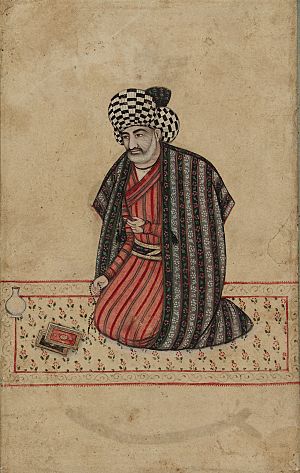Mohammad-Baqer Majlesi facts for kids
Quick facts for kids Mohammad-Baqer Majlesi |
|
|---|---|

Portrait of Mohammad-Baqer Maljesi
|
|
| Religion | Shi'ism |
| Denomination | Shia |
| Personal | |
| Born | 1627 Isfahan, Safavid Iran |
| Died | 29 March 1699 (aged 71–72) Isfahan, Safavid Iran |
| Senior posting | |
| Period in office | 1687 - 1699 |
| Successor | Muhammad Salih Khatunabadi |
| Religious career | |
| Works | Bihar al-Anwar |
| Profession | Clergyman, jurist |
| Post | Shaykh al-Islām of Isfahan |
Mohammad Baqer Majlesi (born 1627 – died 1699) was a very important Twelver Shia scholar and thinker. He lived during the Safavid time in Iran. People often called him Allamah Majlesi, which means "Great Scholar."
Many people believe he was one of the most powerful and important Shia religious leaders ever. His ideas and actions helped shape how Twelver Shi'ism developed from his time onwards. He was buried next to his father in a family tomb near the Jamé Mosque of Isfahan.
Contents
Early Life and Learning
Mohammad Baqer Majlesi was born in Isfahan in 1617. His father, Mulla Mohammad Taqi Majlesi, was also a respected religious scholar. His family was known for its scholars.
By the time he was 25, Majlesi had become a certified teacher. He studied under 21 different masters. It is said that he taught 181 students who later became masters themselves.
His Influence and Beliefs
In 1687, the Safavid King, Sultan Husayn, chose Majlesi to be the "Sheikh ul-Islam" of Isfahan. This was the highest religious position in the Persian Empire at that time. In this powerful role, he had a lot of freedom to guide people.
Majlesi worked hard to strengthen the beliefs and practices of Twelver Shi'ism. He wanted to make sure that religious teachings were clear and followed correctly. He also encouraged people to convert to the Shia school of thought.
Before Majlesi, some Shia scholars were also influenced by Sufism (a mystical branch of Islam) and certain philosophical ideas. Majlesi helped to separate these ideas from the main path of Twelver Shi'ism. After him, Sufism and philosophy became less central to religious studies in Shia colleges.
Shaping Religious Practices
Majlesi is known for making many Shia rituals more popular. These include the Mourning of Muharram ceremonies. These ceremonies remember the martyrdom of Husayn ibn Ali at Karbala. He also encouraged pilgrimages to the shrines of the Imams and their families.
He strongly believed in "enjoining the good" and "forbidding evil." He provided religious judgments (called fatwa) for many situations. He wanted to guide believers in all parts of their lives.
Majlesi believed that true "science" was about understanding God's clear messages in the Quran. It also included knowing religious duties and the teachings of the Prophet (called Hadith). He warned that seeking other kinds of knowledge could be a "waste of one's life."
His Works and Contributions
Allamah Al-Majlisi was most interested in hadith, which are sayings and actions of Prophet Muhammad and the Imams. He made his teachings easy to understand for everyone. He wrote many books in both Arabic and Persian. He wrote over 100 books in total.
Some of his most famous books include:
- Bihar al-Anwar ("Seas of Light"), which has 110 volumes.
- Reality of Certainty
- Mirror of Intellects, a 26-volume commentary.
- Shelter of the Upright People, a 16-volume commentary.
- Provisions for the Hereafter
- A Gift for the Pilgrims
- Essence of Life
- Adornment of the Pious
- Al-Fara'edh al-Tarifah
See also
 In Spanish: Muhammad Baqir Maylisi para niños
In Spanish: Muhammad Baqir Maylisi para niños
- Safavid conversion of Iran to Shia Islam
- Du'a al-Kumayl
- Sharif al-Murtaza
- Al-Sharif al-Radi
- Al-Shaykh Al-Mufid
- Shaykh Tusi
- ibn Babawayh
- Muhammad ibn Ya'qub al-Kulayni
- Amina Bint al-Majlisi
- Al-Hurr al-Aamili
- Aliqoli Jadid-ol-Eslam

